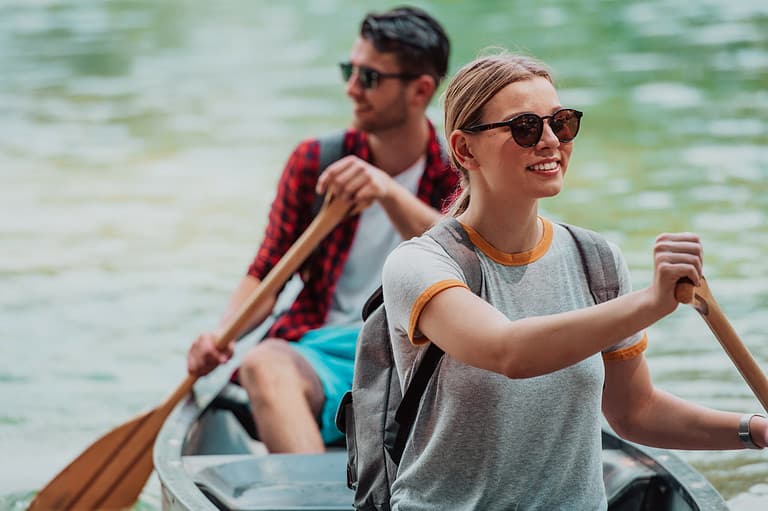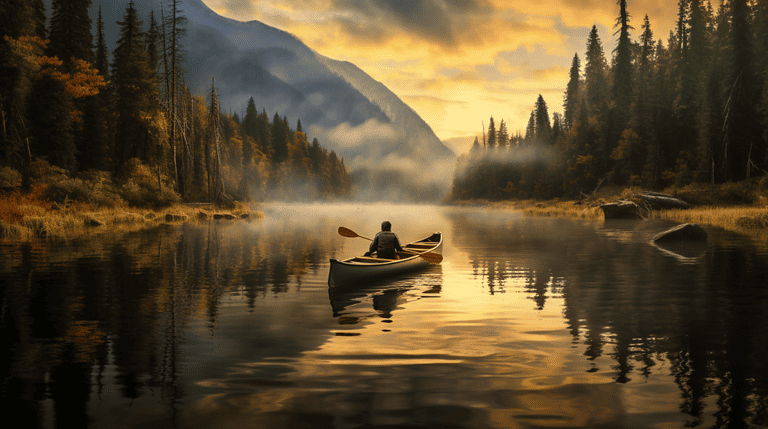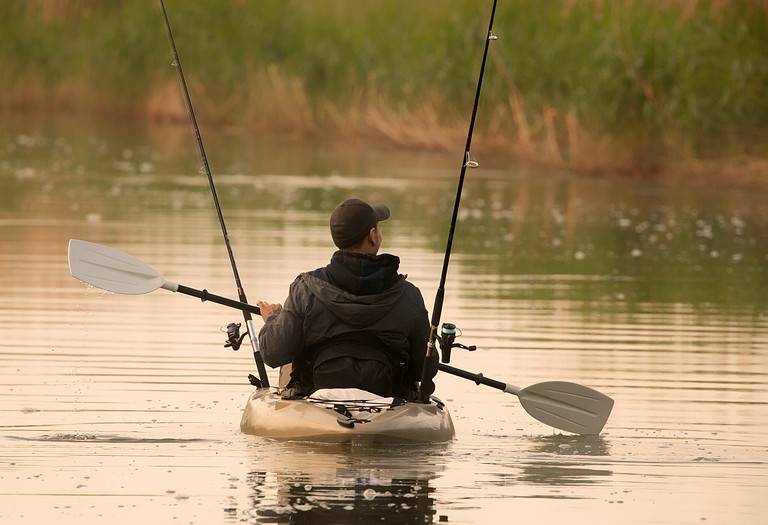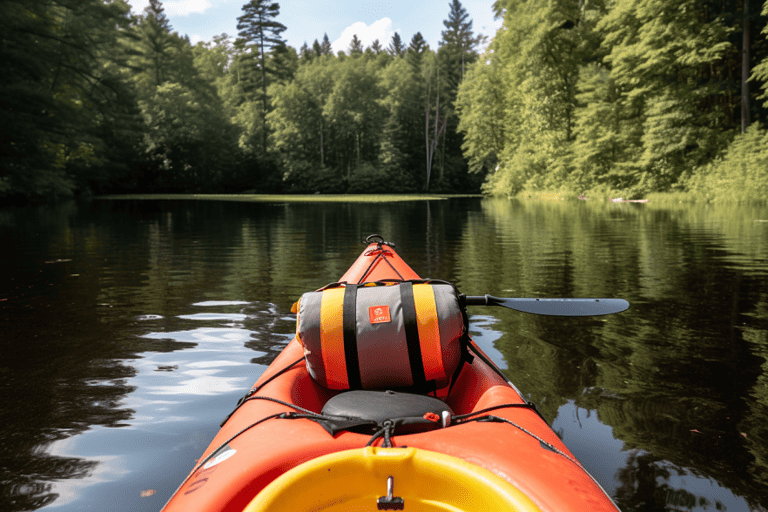Canoeing Equipment And Gear
Are you planning a canoeing trip? Make sure you have the right Canoeing Equipment And Gear it’s important to ensure a safe and enjoyable experience. Several factors must be considered before hitting the water, from choosing the right canoe to packing essential items.
Firstly, selecting the appropriate canoe is crucial. Canoeing benefits include good exercise and enjoying nature, so make sure you are prepared. The size and shape of your canoe will depend on your intended use, whether for solo paddling or carrying gear for a multi-day excursion. Additionally, it’s essential to select a durable material such as aluminum or fiberglass that can withstand rough waters and potential scrapes along rocky riverbeds. With so many options available on the market, taking the time to research and choose the perfect canoe will make all the difference in your overall experience.
Key Takeaways
- Choosing the right canoe, paddle, life jacket, and waterproof bag is crucial for a safe and enjoyable canoeing experience.
- Optional equipment such as GPS, satellite phones, dry bags, a waterproof camera or a waterproof camera case, and a portable water filter can greatly improve the overall experience and provide peace of mind.
- Proper maintenance and care of equipment are important for longevity and performance, as canoeing gear will be exposed to various weather conditions and potential damage.
- Consult with experienced paddlers or outfitters for the best equipment recommendations, prioritize necessary safety gear, and always be prepared with necessary gear and equipment.
Choose the Right Canoe
Choosing the right canoe can make or break your paddling experience, so it’s essential to consider several factors before purchasing. One crucial factor is canoe materials. Canoes are typically made of aluminum, fiberglass, wood, or plastic. Aluminum canoes are durable and low maintenance but heavy, while fiberglass canoes are lightweight and fast but require more maintenance. Wooden canoes offer a classic look and feel but need regular upkeep. Plastic canoes are affordable and low-maintenance but may not be as comfortable to paddle.
Another critical factor to consider is weight distribution. The canoe’s weight should be evenly distributed across the boat’s length for optimal stability and maneuverability on the water. If you plan on solo paddling, choose a shorter canoe that’s easy to handle alone. For tandem paddling with a partner or children, opt for a longer boat with a higher weight capacity. Now that you’ve chosen the perfect canoe for your needs, let’s move on to selecting an appropriate paddle for your adventure!
Paddles
Once you’ve got a paddle, it’s important to check its length and blade shape. Paddle length plays a crucial role in how comfortable and efficient your stroke will be. A paddle that is too long can cause excessive strain on your arms, shoulders, and back while paddling. Conversely, a too short paddle can cause inefficient strokes and limit the amount of power you can generate.
When it comes to choosing the right paddle materials, there are several options available such as wood, aluminum, fiberglass, carbon fiber or plastic. Each material has its own set of advantages and disadvantages based on weight, durability or price range. It’s also important to consider the shape of the blade; some blades are designed for speed while others are better suited for maneuverability in choppy waters. By selecting the right materials and blade design for your paddling needs, you’ll have a more enjoyable experience out on the water.
Transitioning into life jackets – Safety should always be at the forefront of any canoeing trip. While paddles may seem like the most important piece of canoeing equipment, life jackets cannot be overlooked as they play an essential role in keeping you safe during emergencies or accidental fall-ins.
Life Jackets
To ensure your safety while out on the water, it’s crucial that you wear a properly fitting life jacket that will keep you afloat in case of an emergency or accidental fall-in. Different types of life jackets are available in the market, including Type I, II, III, IV and V. Each type is designed for specific activities and water conditions. For example, Type I jackets are best suited for open waters with rough conditions, while Type III jackets are ideal for calm inland waters.
Inspecting and maintaining your life jacket regularly is important to ensure its effectiveness. Check the manufacturer’s recommendations for care and storage. Before each use, examine the jacket carefully for any signs of damage such as tears or leaks. If you notice any problems with your life jacket, don’t hesitate to replace it immediately. With proper maintenance and care, your life jacket can provide you with years of reliable protection on the water. As we discuss waterproof bags in the next section, remember that keeping your personal belongings dry while canoeing is just as important as wearing a proper life jacket!
Waterproof Bags
When it comes to waterproof canoeing bags, you should keep a few things in mind. First and foremost, make sure you choose the right size for your needs. Look for durable and water-resistant materials to ensure that your gear stays safe and dry. Finally, consider the number of compartments in the bag as this can greatly affect how organized your gear will be on the water. By following these tips, you’ll be well on your way to choosing the perfect waterproof bag for your next canoeing adventure!
Choose the Right Size
Make sure you’re getting the perfect fit for your canoeing gear by choosing the right size – it’ll make a difference in your experience on the water! Here are some sizing tips to help you pick out the right waterproof bag:
- Consider weight capacity: Make sure to choose a bag that can hold all of your belongings and has enough weight capacity for any additional items you may need to bring.
- Look at dimensions: Check the bag’s dimensions to ensure it will fit comfortably in your canoe and won’t take up too much space.
- Think about portability: If you plan on carrying the bag while hiking or portaging, consider a smaller size that is easier to transport.
- Try before you buy: If possible, try on different sizes and test them out with your gear to see which one is most comfortable for you.
Ensuring that you have chosen the right size waterproof bag can be crucial when it comes to keeping your belongings safe and dry during your canoe trip. Once you have found the perfect fit, it’s important to also look for durability and water resistance in order to protect against any potential leaks or damage from rough waters.
Look for Durability and Water Resistance
You’ll want gear that can handle the elements, so make sure your waterproof bag is tough and resistant to water. Regarding canoeing equipment and gear, durability and water resistance are important factors to consider. Your gear will be exposed to various weather conditions like rain, wind, and waves, as well as potential scratches or damages from rocks or branches in the water.
To ensure that your gear lasts for a long time and doesn’t negatively impact your performance on the water, it’s essential to maintain it properly. Regularly check for any tears or damages in your waterproof bag and patch them up immediately if you find any. Also, clean and dry your gear after each use to prevent mold growth or other issues that may arise from moisture. By taking good care of your canoeing equipment and gear, you can guarantee its longevity while also improving your overall experience on the water.
With these tips in mind, it’s important to consider the number of compartments when choosing a waterproof bag for your canoeing adventures. This factor will affect how organized you can keep your belongings during trips while also ensuring easy access when needed.
Consider the Number of Compartments
To keep your belongings organized and easily accessible on your canoeing trips, imagine a waterproof bag with multiple compartments that allow you to quickly grab whatever you need without rummaging through everything. Here are some organization tips to consider when choosing a bag with multiple compartments:
- Think about weight distribution: When packing for your trip, distribute the weight evenly between the compartments. This will help keep your canoe balanced and prevent it from tipping over.
- Use color-coded bags: To make it easier to find what you need, use different colored bags for different items. For example, use a red bag for first aid supplies and a blue bag for cooking utensils.
- Label each compartment: Labeling each compartment can save time and frustration when trying to find something quickly. Use waterproof labels or write directly on the bag with a permanent marker.
Considering these organization tips, you can ensure your gear is easily accessible and well-distributed in your canoe. Now let’s move on to optional equipment that can enhance your canoeing experience even further.
Optional Canoeing Equipment List
If you want to take your canoeing experience to the next level, consider bringing along some optional gear that will enhance your canoeing equipment and their uses to ensure you have the necessary safety equipment for canoeing that is not just a Life Jacket and Paddle. Think about a GPS or satellite phone that are as essential to canoeing as a compass is to a hiker. While packing essentials and safety measures are important, these optional items can enhance your trip and provide added convenience.
Here’s a table of some recommended optional equipment for your next canoeing trip:
| Equipment | Description |
| GPS | A handheld device that uses satellites to pinpoint your location on a map. Useful for navigation in areas with few landmarks or when visibility is low. |
| Satellite Phone | Allows you to make calls and send messages from remote locations where cell service isn’t available. Can be crucial in an emergency situation. |
| Dry Bags | Waterproof bags that keep your belongings dry while paddling through rapids or rainstorms. Available in different sizes for storing everything from clothes to electronics. |
| Portable Water Filter | Enables you to drink water straight from the river or lake without worrying about contaminants or bacteria. Ideal for multi-day trips where carrying enough water is difficult. |
These items may not be necessary for every trip, but they can greatly improve your overall experience and provide peace of mind in case of unexpected situations. Before considering any additional equipment, ensure you have all the necessary safety gear, and always consult with experienced paddlers or outfitters on what items would be best suited for your specific canoeing adventure.
Conclusion
So, you’ve got all the equipment and gear necessary for a successful canoe trip. Congratulations! But before you embark on your adventure, let’s take a moment to highlight an interesting statistic: according to the Outdoor Industry Association, over 14 million Americans participate in canoeing each year. That’s a lot of people hitting the water!
Now that you’re part of this impressive group, it’s important to remember that choosing the right equipment is key. A well-fitted life jacket can be the difference between safety and danger in case of an accident. The right paddles will make maneuvering through currents and rapids easier and more efficient. And don’t forget waterproof bags – they’ll keep your belongings safe from water damage.
In addition to these essentials, optional equipment can enhance your experience even further. Consider investing in a waterproof camera to capture stunning nature photos while on your trip. Or perhaps bring along some fishing gear if you plan on spending time fishing during breaks from paddling.
The proper equipment and gear is crucial for a successful canoe trip. So hit those waters with confidence – knowing you have everything you need for a safe and enjoyable journey!





